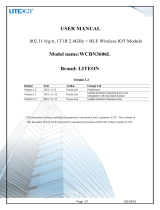
This device complies with Part 15 of the FCC Rules. Operation is subject to the
following two conditions:
(1) this device may not cause harmful interference, and
(2) this device must accept any interference received, including interference that may
cause undesired operation.
Any changes or modifications not expressly approved by the party responsible for
compliance could void the user’s authority to operate the equipment.
Please notice that if the FCC identification number is not visible when the module is
installed inside another device, then the outside of the device into which the module is
installed must also display a label referring to the enclosed module. This exterior label
can use wording such as the following: “Contains FCC ID:2AXJE-LA-WE2S” any
similar wording that expresses the same meaning may be used.
This equipment complies with FCC radiation exposure limits set forth for an
uncontrolled environment. This equipment should be installed and operated with a
minimum distance of 20cm between the radiator & your body. This transmitter must
not be co-located or operating in conjunction with any other antenna or transmitter.
The module is limited to OEM installation ONLY.
The OEM integrator is responsible for ensuring that the end-user has no manual
instruction to remove or install module.
A separate approval is required for all other operating configurations, including
portable configurations with respect to Part 2.1093 and difference antenna
configurations.
There is requirement that the grantee provide guidance to the host manufacturer for
compliance with Part 15B requirements.
The OEM integrator is responsible for ensuring that the end-user has no manual
instructions to rem-ove or install module.
The module is limited to installation in mobile or fixed application.



















